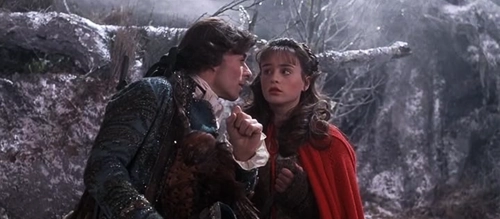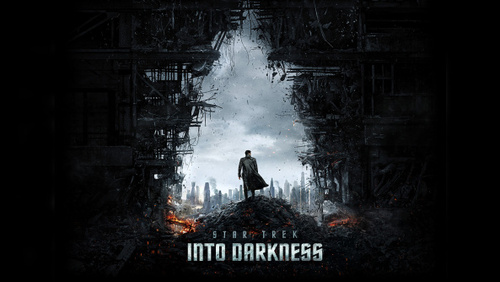
The Company of Wolves (1984)
Director: Neil Jordan
Screenwriters: Angela Carter, Neil Jordan
Starring: Sarah Patterson, Angela Lansbury, David Warner, Tusse Silberg, Micha Bergese
Toward the end of Neil Jordan’s 1984 fantasy horror film The Company of Wolves, a little girl, dressed in a blood red cape, walks alone in a silent wood on the way to her grandmother’s house. The words of her granny, superstitious and puritanical, echo in her head: “never stray from the path and beware of men whose eyebrows meet in the middle, for all the most dangerous wolves are hairy on the inside.” It is not long before the little girl meets a handsome man, dressed in fine clothes, with eyes yellow as the moon. When he seemingly has her in his clutches, a chorus of howls ring out in the night.
“Who’s come to sing us carols, then?” the little girl asks the man. He replies, “Only my companions, darling. I love the company of wolves.”
It would be easy to guess how this story ends. After all, it’s a story we’ve been told before. For children, it’s a cautionary tale about the dangers of trusting strangers. For girls on the cusp of womanhood, it might speak to the consequences of straying from the path of propriety and allowing predatory men to take advantage of them. In almost every version, the little girl invites her own demise. The morality at the center of The Company of Wolves, based on journalist and writer Angela Carter’s seminal fairy tale anthology “The Bloody Chamber”, is far more complex than that. Set within the world of a pubescent teenage girl’s wild dreams, The Company of Wolves is a surreal tale about the pain and pleasure of growing up that takes an iconic figure in folklore and turns her into more than a victim of her own story. With intoxicating cinematography by Bryan Loftus and a fierce, layered performance from star Sarah Patterson in her film debut, The Company of Wolves explores the animalistic nature in all of us.
Told in a series of vignettes, the film begins with 13-year-old Rosaleen (Sarah Patterson) asleep in the attic bedroom of her family’s country estate. Rosaleen tosses and turns, seemingly unable to wake herself from whatever dream or nightmare she is deeply absorbed in. Outside, the sun begins to set as the darkness of the woods closes in on her. In her bedroom, Rosaleen is surrounded by dolls perched on shelves, untouched and collecting dust, who seem to watch her with glassy, dark eyes. Her lips are smeared with red lipstick that doesn’t belong to her – a child playing dress up in her older sister’s clothes. In this moment, Rosaleen is caught in that liminal space between childhood and adulthood.
Rosaleen dreams that she lives deep in the woods of a nightmarish version of 18th century Europe, where danger lurks around every corner and every man can turn monstrous, no matter how charming or good. The woods are endless and magical, steeped in mist, teasing with desire. Rosaleen’s sister Alice (Georgia Slowe) has just been murdered by wolves and their grandmother (Angela Lansbury) warns Rosaleen to never stray from the path as her sister did – to never invite a wolf to swallow her whole. Throughout the film, Granny and Rosaleen tell stories to each other that build upon the central theme, culminating in that famous confrontation between Rosaleen and the wolf, who first appears to her as an attractive, well-dressed Huntsman (Micha Bergese).
Though Angela Carter before her untimely death in 1992 wrote extensively, publishing short stories, radio plays, novels, poetry and children’s books, her most well-known work is certainly “The Bloody Chamber“, a series of feminist reworkings of classic fairy tales. From “Beauty and the Beast” to “Puss in Boots,” Carter’s take on those famous tales is decidedly sexual and subversive. Carter explores themes of female liberation and desire, and her heroines usually undergo a sexual awakening, a metamorphosis that is sometimes literal. There is a timeless, magical quality to Carter’s biting prose and she often infuses her stories with elements of gothic horror. It would be impossible to capture Carter’s words perfectly, but The Company of Wolves is probably the closest representation we could hope for. Having Carter herself co-write the script with director Neil Jordan certainly helped in preserving the feeling her works evoke, but it is clear that Jordan himself had an understanding of it as well. In The Company of Wolves, Jordan has no interest in flattening Carter’s complex mythos and instead embraces it.

Aesthetically, The Company of Wolves is highly stylized and does its best to visualize the otherwordly quality of Carter’s prose. Jordan and production designer Anton Furst (later known for Batman, 1989) manage to make a forest built on a sound stage feel vast and endless, dripping in mist and sensual danger. At the same time, there are moments when it feels consciously artificial, emphasizing the fact that this is all playing out in Rosaleen’s imagination, where she sees herself acting out her fears and anxieties of growing up. The Company of Wolves is surreal and strange, far more allegorical than literal. In one scene, the Devil (played by Terence Stamp in an uncredited cameo), appears in the woods riding in a white Rolls Royce, driven by Rosaleen herself in a white wig. In another, Rosaleen’s sister Alice is chased by a pack of wolves through the woods, whose floor is littered with giant, nightmarish versions of her childhood toys. Even the special effects are grotesque and unnerving, and are responsible for some of the most creative werewolf transformations on film.
Patterson’s ability to carry the film is remarkable considering her young age. Though Rosaleen lacks experience, she is curious about the world and quietly stubborn, often pushing back against her fearmongering Granny. Patterson balances these seemingly contradictory elements with ease, giving us a heroine that is anything but one note. Jordan’s direction no doubt allowed Patterson the freedom to give such a layered performance, as he would later do with a young Kristen Dunst in 1994’s Interview with the Vampire. The script gives Rosaleen a tremendous amount of agency and never frames her budding desire as something to be ashamed of or punished for.
The Company of Wolves is made up of several different movements that all build on the central motif. Granny’s tales to Rosaleen offer a grim vision of the future: one where men prey on young women and wolves devour their innocence and youth. Rosaleen’s stories, however, reveal that a wolf’s nature does not solely belong to men – that women have the capacity for it too. As Rosaleen’s Mother (Tusse Silberg) tells her, “If there’s a beast in men, it meets its match in women, too.” Using lycanthropy as a metaphor for puberty itself, and not simply the destructive desires of man, is something we continue to see on film, most notably in 2001’s Ginger Snaps.
The Company of Wolves does not offer a happily ever after. It stands instead at the threshold of childhood, tempting us to step over that doorway and into the inevitability of adulthood. It’s a film about the act of becoming. Weird, magical and sensual, The Company of Wolves is a rich and layered fairy tale adaptation that turns a classic story on its head and invites us to relive the beauty and horror of growing up.
Score: 19/24

